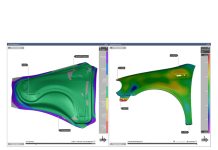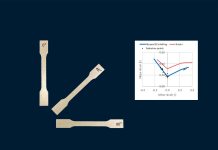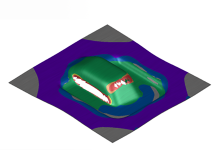Interview with Bernd Glasbrenner Senior Process Consultant at AutoForm
All the Little Details involving Stamping Simulation
and Tool Tryout that Amount to the Totality of Accuracy
Today’s exciting interview is with Bernd Glasbrenner, Senior Process Consultant at AutoForm, who joins us to answer questions on how to achieve accurate predictions in practice, describing in detail some of the obstacles for comparability between stamping simulation and tool tryout.
Bernd, what is accuracy and its effects in reality?
 There are two major aspects of achieving accuracy. The first is that the virtual model should take all relevant factors into account to represent the physical model as much as possible. Take, for example, the geometries of the tools used for forming the part shape. Or, take the measurement device used to assess the geometric deviations between an actual stamped part with the simulation result. Another factor are the stresses that are introduced into the material during forming, as external forces induce strains in the sheet material and stresses interact with the material’s own properties. Also, gravity is one of many other influences which need to be taken into account. The totality of considerations needed to build a truly relevant simulation model is complex and multi-faceted.
There are two major aspects of achieving accuracy. The first is that the virtual model should take all relevant factors into account to represent the physical model as much as possible. Take, for example, the geometries of the tools used for forming the part shape. Or, take the measurement device used to assess the geometric deviations between an actual stamped part with the simulation result. Another factor are the stresses that are introduced into the material during forming, as external forces induce strains in the sheet material and stresses interact with the material’s own properties. Also, gravity is one of many other influences which need to be taken into account. The totality of considerations needed to build a truly relevant simulation model is complex and multi-faceted.
The second aspect for accuracy is to use meaningful simulation parameters. They shouldn’t only be accurate (in the sense described above) but they should also make sure that relevant results can be obtained in a feasible time span. For economic simulation models we should ensure that not all, but only the most necessary parameters accurately describing the analyzed process come into play.
An Example of Meaningful Accuracy: Physical Draw Bead vs. Line Model
This might better demonstrate the effectiveness and efficiency of simulation.
For the simulation of the closing of the dies we recommend using 3D beads (i.e. actual 3D geometric representation of the shapes of the drawing beads) on the binder so sheet wrinkles, waviness and material accumulations that arise during the tool closing can be seen in the simulation results. At the end of the drawing stage you may use the unflattening option in our software reverting to a 2D-representation of the draw beads used for efficient simulation of the actual drawing operation.[1] Bear in mind that using draw beads introduce stiffness into the sheet. If you inserted that panel into the next operation the panel stiffness would be different using 3D and 2D beads. Nevertheless during the drawing stage we try to use the line bead model seeing that is much faster than using 3D beads. For the draw stage this is common practice since it saves computing time. Currently there is no comparable model like the flattening-unflattening process for the draw steps.[i]
How do tensile and compressive stresses come into play?
Here, two major considerations are worth mentioning. The first is the material properties: they should represent the actual behavior of the sheet material you use in tryout and production. The aging properties of aluminum or bake hardening steel may also need to be considered, seeing that if those panels have been stored on shelves for six months then the real material properties you have on hand are most likely not comparable to those you have used in simulation.
The second point concerns making sure you introduce the same strains into the panel in actual stamping and in simulation. This involves ensuring the same starting situation – position and shape – for the blank at the closing of the dies. You’ll measure the material draw-in and the material flow across radii within the punch area. The material movement across radii is significantly influenced by the tribology system (tool, lubricant, blank). In the flange area of the sheet other factors control draw-in such as the spotting of the dies and the draw bead itself while, of course, tribology here also plays an important role. Thus externally you have several factors influencing the forming process, while over the punch the stresses are mainly influenced by the tribological system. You could project it into an easy picture, and state you merely need to concentrate on geometries and stresses alone, but once you dig deeper all these other factors come into play and need to be taken into account.

What about tool kinematics and how does this relate to accuracy?
The actual tool kinematics must be modeled in the simulation so that all significant physical effects are taken into account. For instance, in the drawing phase we have to identify the ideal position for the binder vs. the punch. For well-defined blank positioning the punch supports the sheet and thus prevents sagging of the blank. This correctly simulates the bending of the sheet metal part and the effects that occur when closing the drawing tool. Tool kinematics also play an important role in follow-up operations. Let’s say the subsequent operation involves a cam, a filler cam and a pad coming from above. Now it is important to define the process as it should run later in the tool. When inserting the formed part, the tool components must be in the correct position. Subsequently, the tool components should be moved according to the real process. This procedure ensures that the sheet metal part position and the tool impact conform to the real process. Positioning problems and unwanted deformations become visible, are comparable and can be corrected.
What are common engineering pitfalls counterproductive to accuracy?
There are several obstacles to achieving accuracy worth mentioning here.
Firstly, I would say one of the most common obstacles to achieving accuracy is when the tryout team is not fully informed by the engineering department. The transfer of information to tryout is critical for efficiency and success and process engineers need to ensure that all relevant simulation results are available at the start of the tryout process.
Secondly, contrary to positive knowledge transfer engineers tend to take shortcuts in order to meet their deadlines. They’ll stop short to ‘get the job done’ and such shortcuts are going to show up in tryout.
Recently I was involved in a project where the drawing simulation was not brought to completion by the process engineer, which meant that there were splits 15 mm before BDC, as well as heavy wrinkling. However, in most companies engineering work is not as bad as in this case. Engineers will often perform the full process of simulation until the end. Yet they have failed to ensure process ability which is the third pitfall we see, and need to deal with having a stable position for the panel as I have said, on whether or not the panel continues in the same position as it enters the next operation.
It might happen, for example, that the closing of the upper and lower tools for a trimming operation has not been properly simulated or evaluated, which is why deformations during this phase were not foreseen and eliminated in the engineering phase. Today, forming simulation tools are capable of providing solutions for all of these issues, and many of those aim at bringing reality ever closer to the accuracy presented in simulation results.
Lastly there is the cardinal sin against accuracy. Engineers might start to toy with the parameters in the simulation set up, believing they will achieve more accuracy. It’s all too common that they draw upon proven parameters that accomplished good results from another software, even competitors software, assuming that these ‘good parameters’ will be helpful when applied across PamStamp, Dyna and AutoForm software. The assumption is that they can now use these parameters and that they must work across all software systems. However, this assumption is incorrect and leads to accuracy failures and, often, much higher calculation times.
True, certain factors like gravity and pressures applied to panels are universal. Engineers often attempt this use of foreign parameters when results do not always return from tryout. At this point they’ll attempt to import these parameters believing the results will bear some relevance. Or they’ll spend time simulating the same part using more than one simulation system, this time each using their distinct parameters correctly. Yet all of this does not contribute to transferring simulation results in the reality of tryout or mass production.
This is why AutoForm-TryoutAssistant is so important at this point because it brings the true results of tryout into the accuracy feedback loop. It enables process engineers to learn from the observed deviations from simulation in tryout, and to potentially adjust their simulations to incorporate findings made in the tryout process. Where some engineers have taken shortcuts to meet deadlines by playing around with the accuracy settings and attempting to speed up the simulation. If the deep engineering knowledge encapsulated in the simulation results and the process optimized during the engineering phase could be transferred to tryout, much time could be saved optimizing the real process.
What influence does the selection of supports, clamps and the direction of gravity have on the measurement results of an actual stamping?
In terms of accuracy the measurement set-up (to position holes, pilots and pickup points) is of supreme importance. There are two aspects at work here. Firstly the measurement device and the manufacturing process should be coordinated to achieve a repeatable and reliable result. Thus measurements must remain consistent as compared, for example, to having different pick up points at each step. Tolerances for hole dimensions and and positions add up, leading to position failures.
Secondly the issue arises on whether or not the measuring system is the same as that which was used in simulations in order to ensure that the results are comparable.
If you consider the influence of the manufacturing process on the measuring method there are many subtle details that come into play and interact. You might start with the drawing stage, then the panel goes into a trimming operation whereby two holes are added, and then the panel moves into the next operation. You could use the two holes made from the previous operation as pilot holes in order to ensure accurate panel positioning, and you might introduce additional holes for the next operation. In the end you place the panel into the measuring device and use some other locations to position that panel. Now, from each operation to the next one, you have location/positioning tolerances of 0.2 mm to 0.3 mm, which does not seem very much at all. These tolerances, however, accumulate and add up towards the end of the process. So you must be aware of which holes and pilots you use in the measuring device and if the position is precisely the same, accounting for the accumulated tolerances. Is this exactly comparable to what you have defined in your simulation set-up? This is just one of many effects which introduce deviations resulting in accuracy losses.

How can you trust in the results that you have at the end?
In order to trust in your results you have to trust in the process itself, and here I mean process ability which is how you insert a component into one operation, what happens if you close the tools etc. Once you reach the end of the process you should additionally run a robustness analysis with AutoForm-Sigma in order to become aware of what happens in terms of process related issues. So first you should achieve a successful simulation set-up for the intended process. To ensure that production results match simulation results the process capability needs to be checked in the digital phase by the user. A simulation can – in our mind – only be called a success if it can prove that the intended production process is capable of handling any variations that actually occur during real-life production. In other words, accuracy goes far beyond matching one simulation result with one measurement of an actual panel. Today, we need to expand the concept of accuracy to being able to accurately predict all forming issues which will arise in the actual mass production environment.
The variances that arise from not accounting for such tolerances of movement between each process: is this a matter of human error, perhaps of not simulating all process steps required to produce the part?
Indeed, not all users are aware of the importance of all the process steps in a typical stamping production. They might think it’s acceptable to jump a few steps, for example, they might ignore the trimming operation, assuming that trimming is a simple process. Nevertheless we indeed see an impact if we close the tools right in the trim stage, carefully evaluating the result of the drawing stage, which might entail some shrinkage or unwanted deformations of the drawn panel. Now if you were to just go ahead and use the trimming operation without utilizing trimming tools then naturally that shrinkage of the panel would show up in subsequent forming stages. Sometimes users are not aware that such shrinkage even occurs. That’s why our recommendation is to always use a full set up for simulations, including the full production cycle with all its process steps. Here full consideration is given not only to the insertion of the component and each manufacturing step, but also to the relaxation of the material at the end of the process. This way your simulation mimics the real tools and material behavior. Here you leave nothing out in simulation, never a single step that is relevant for tryout.
What is the future for simulation accuracy?
The future for accuracy is to spread the knowledge through training all over the AutoForm world. Such training though is just the first step. The second step arises in the observation of the daily use of this knowledge. After customers run simulations the future is to obtain even more feedback on their results, to find out what problems have arisen and to further iron out those issues. In this way the accuracy between simulation and tryout all over the world will increase thanks to strengthened feedback loops bringing simulation accuracy ever closer to reality.
[1] At closing you have the geometric draw bead. After tool closing the geometric bead is flattened and the drawing process uses the much faster enhanced line bead model. After the drawing process the geometric beads (3D beads) are applied again using the unflattening option. Thus the real stiffness of the drawn panel is used for the following insertion process into the trim operation etc.
Readers, don’t forget to sign up to our blog!
*Cover image courtesy of Weber.













